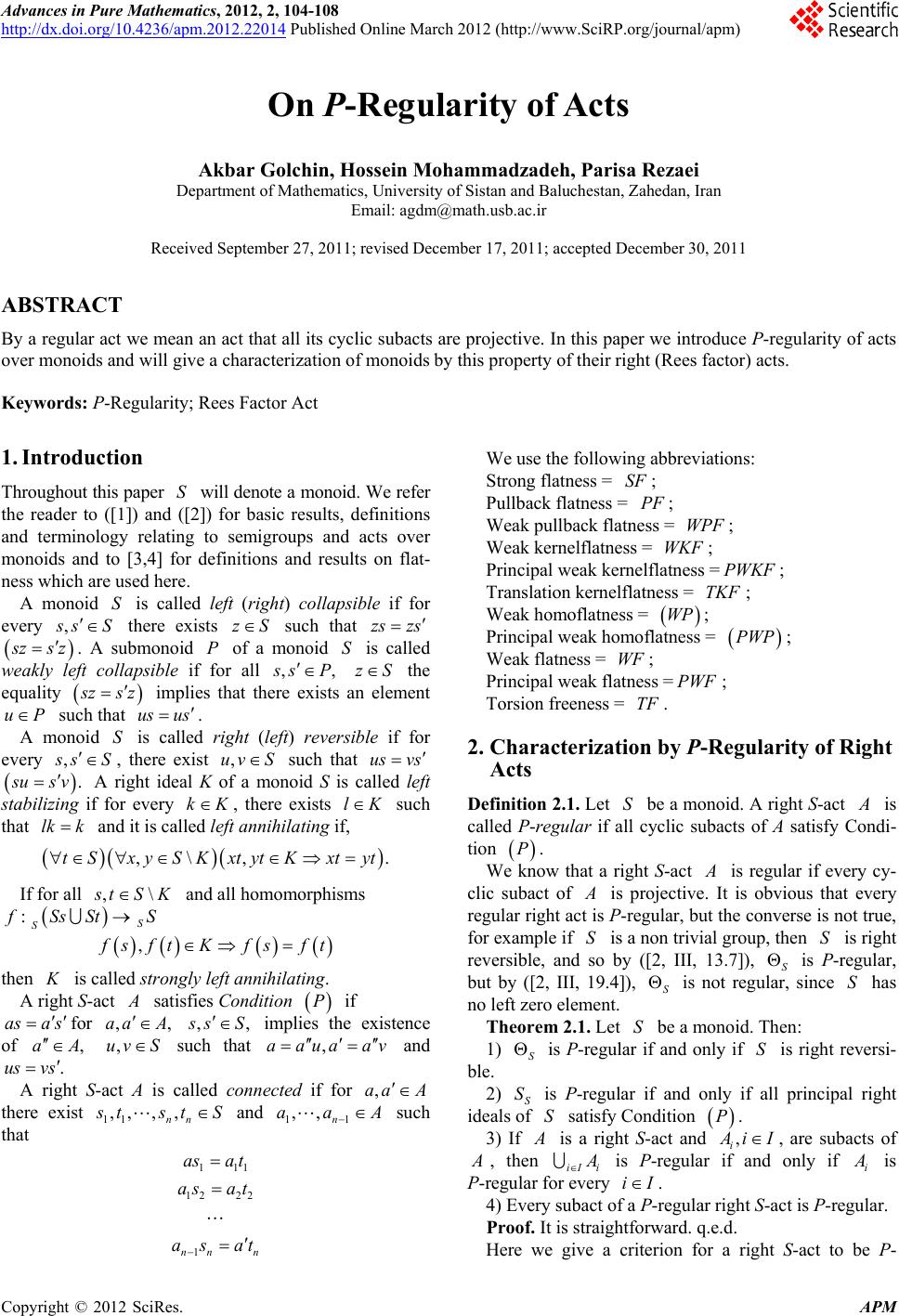 Advances in Pure Mathematics, 2012, 2, 104-108 http://dx.doi.org/10.4236/apm.2012.22014 Published Online March 2012 (http://www.SciRP.org/journal/apm) On P-Regularity of Acts Akbar Golchin, Hossein Mohammadzadeh, Parisa Rezaei Department of Mathematics, University of Sistan and Baluchestan, Zahedan, Iran Email: agdm@math.usb.ac.ir Received September 27, 2011; revised December 17, 2011; accepted December 30, 2011 ABSTRACT By a regular act we mean an act that all its cyclic subacts are projective. In this paper we introduce P-regularity of acts over monoids and will give a characterization of monoids by this property of their right (Rees factor) acts. Keywords: P-Regularity; Rees Factor Act 1. Introduction Throughout this paper will denote a monoid. We refer the reader to ([1]) and ([2]) for basic results, definitions and terminology relating to semigroups and acts over monoids and to [3,4] for definitions and results on flat- ness which are used here. S S , A monoid is called left (right) collapsible if for every s zs zsS there exists such that zS zsz S ,, . A submonoid of a monoid is called weakly left collapsible if for all P sP zS the equality zsz implies that there exists an element such that . uPus , us SA monoid is called right (left) reversible if for every s S, there exist such that ,uvSus vs . us klK ,\ ,.Sx ySKxtytKxtyt v A right ideal K of a monoid S is called left stabilizing if for every , there exists such that and it is called left annihilating if, K lk k t If for all ,\ tSK :S S and all homomorphisms Ss StS , sft Kfsft then is called strongly left annihilating. K A right S-act satisfies Condition if for P as a s ,,A,aa , s S S implies the existence of such that and ,,uvaA ,aau a av ,aa A .usvs A right S-act A is called connected if for there exist 11 ,,, , nn tstS11 ,, n aaA and 111 12 22 1nn n asa t as at as at SF PF WPF WKF PWKF TKF such that We use the follow ing abbreviations: Strong flatness = ; Pullback flatness = ; Weak pullback flatness = ; Weak kernelflatness = ; Principal weak kernelflatness =; Translation kernelflatness = ; WP ; Weak homoflatness = Principal weak homoflatness = PWP WF PWF TF S ; Weak flatness = ; Principal weak flatness =; Torsion freeness = . 2. Characterization by P-Regularity of Right Acts Definition 2.1. Let be a monoid. A right S-act is called P-regular if all cyclic subacts of A satisfy Condi- tion P. We know that a right S-act is regular if every cy- clic subact of is projective. It is obvious that every regular right act is P-regular, but the converse is no t true, for example if is a non trivial group, then is right reversible, and so by ([2, III, 13.7]), S is P-regular, but by ([2, III, 19.4]), S S S is not regular, since has no left zero element. S S S Theorem 2.1. Let be a monoid. Then: 1) is P-regular if and only if is right reversi- ble. S SS 2) S is P-regular if and only if all principal right ideals of satisfy Condition P. is a right S-act and i iI, are subacts of 3) If , , then iI i is P-regular if and only if i is P-regular for every iI . 4) Every subact of a P-regular right S-act is P-regular. Proof. It is straightforward. q.e.d. Here we give a criterion for a right S-act to be P- C opyright © 2012 SciRes. APM 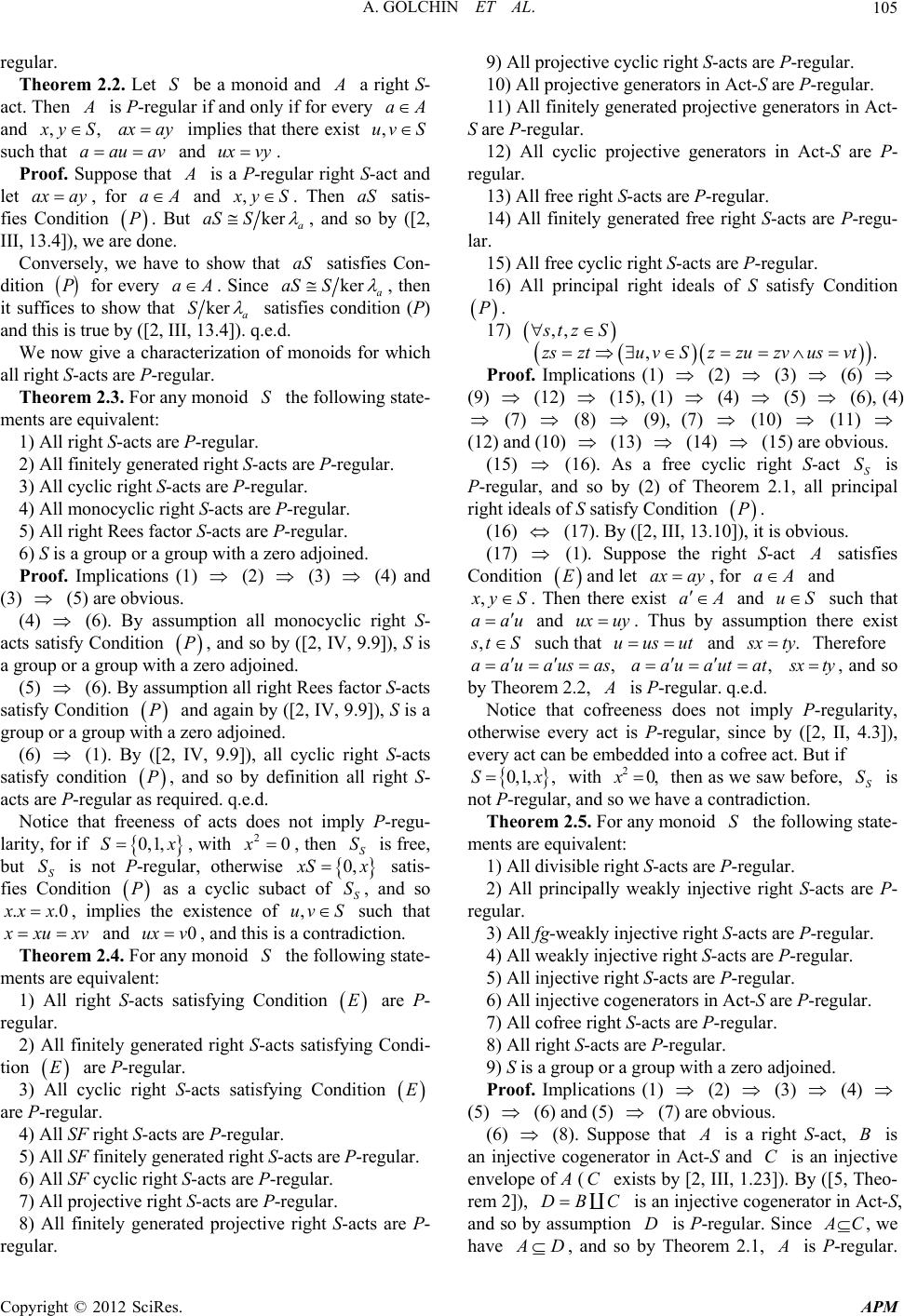 A. GOLCHIN ET AL. 105 regular. Theorem 2.2. Let be a monoid and S a right S- act. Then is P-regular if and only if for every aA and ,, yS ax ay,uv S implies that there exist such that and . aauav ux vy Proof. Suppose that is a P-regular right S-act and let , for and ax ay aA, ySaS. Then satis- fies Condition . But PkerSa aS , and so by ([2, III, 13.4]), we are done. Conversely, we have to show that satisfies Con- dition aS P for every a. Since AkeraS Sa , then it suffices to show that ker a S satisfies condition (P) and this is true by ([2, III, 13.4]) . q.e.d. We now give a characterization of monoids for which all right S-acts are P-regular. Theorem 2.3. For any monoid the following state- ments are equivalent: S P P P x0S S 0, 1) All right S-acts are P-regular. 2) All finitely generated right S-acts are P-regular. 3) All cyclic right S-acts are P-regular. 4) All monocyclic right S-acts are P-regular. 5) All right Rees factor S-acts are P-regular. 6) S is a group or a group with a zero adjoined. Proof. Implications (1) (2) (3) (4) and (3) (5) are obvious. (4) (6). By assumption all monocyclic right S- acts satisfy Condition , and so by ([2, IV, 9.9]), S is a group or a group with a zero adjoin ed. (5) (6). By assumption all right Rees factor S-acts satisfy Condition and again by ([2, IV, 9.9]), S is a group or a group with a zero adjoined. (6) (1). By ([2, IV, 9.9]), all cyclic right S-acts satisfy condition , and so by definition all right S- acts are P-regular as required. q.e.d. Notice that freeness of acts does not imply P-regu- larity, for if , with , then is free, but S is not P-regular, otherwise 0, 1,S2 x S SxS satis- fies Condition as a cyclic subact of S, and so P ..0 xx, implies the existence of such that ,uv S xu xv and , and this is a contradiction. 0ux v Theorem 2.4. For any monoid the following state- ments are equivalent: S 1) All right S-acts satisfying Condition E E are P- regular. 2) All finitely generated right S-acts satisfying Condi- tion are P-regular. 3) All cyclic right S-acts satisfying Condition E are P-regular. 4) All SF right S-acts are P-regular. 5) All SF finitely generated right S-acts are P-regular. 6) All SF cyclic right S-acts are P-regular. 7) All projective right S-acts are P-regular. 8) All finitely generated projective right S-acts are P- regular. 9) All projective cyclic right S-acts are P-regular. 10) All projective generators in Act-S are P-regular. 11) All finitely generated projective generators in Act- S are P-regular. 12) All cyclic projective generators in Act-S are P- regular. 13) All free right S-acts are P-regular. 14) All finitely generated free right S-acts are P-regu- lar. 15) All free cyclic right S-acts are P-regular. 16) All principal right ideals of S satisfy Condition P. ,, tz S 17) ,.zsztu vSzzuzvusvt S P Proof. Implications (1) (2) (3) (6) (9) (12) (15), (1) (4) (5) (6), (4) (7) (8) (9), (7) (10) (11) (12) and (10) (13) (14) (15) are obvious. (15) (16). As a free cyclic right S-act S is P-regular, and so by (2) of Theorem 2.1, all principal right ideals of S satisfy Condition . (17). By ([2, III, 13.10]), it is obvious. (16) (17) (1). Suppose the right S-act satisfies Condition Eax ayand let , for and aA , yS . Then there exist and such that aA uS aau and ux uy . Thus by assumption there exist tS uusut. and such that , xty ,aaua usas Therefore ,aa uautat xty, and so by Theorem 2.2, is P-regular. q.e.d . Notice that cofreeness does not imply P-regularity, otherwise every act is P-regular, since by ([2, II, 4.3]), every act can be embedded into a cofree act. But if 0,1,,Sx20,x with then as we saw before, is not P-regular, and so we have a contradiction. S S S Theorem 2.5. For any monoid the following state- ments are equivalent: 1) All divisible right S-acts are P-regular. 2) All principally weakly injective right S-acts are P- regular. 3) All fg-weakly injective right S-acts are P-regular. 4) All weakly injective right S-acts are P-regular. 5) All injective right S-acts are P-regular. 6) All injective cogenerators in Act-S are P-regular. 7) All cofree right S-acts are P-regular. 8) All right S-acts are P-regular. 9) S is a group or a group with a zero adjoined. Proof. Implications (1) (2) (3) (4) (5) (6) and (5) (7) are obvious. (6) (8). Suppose that is a right S-act, is an injective cogenerator in Act-S and is an injective envelope of A (C exists by [2, III, 1 .23]). By ([5, Theo- rem 2]), B C DBC D is an injective cogenerator in Act-S, and so by assumption is P-regular. Since C, we have is P-regular. D, and so by Theorem 2.1, Copyright © 2012 SciRes. APM 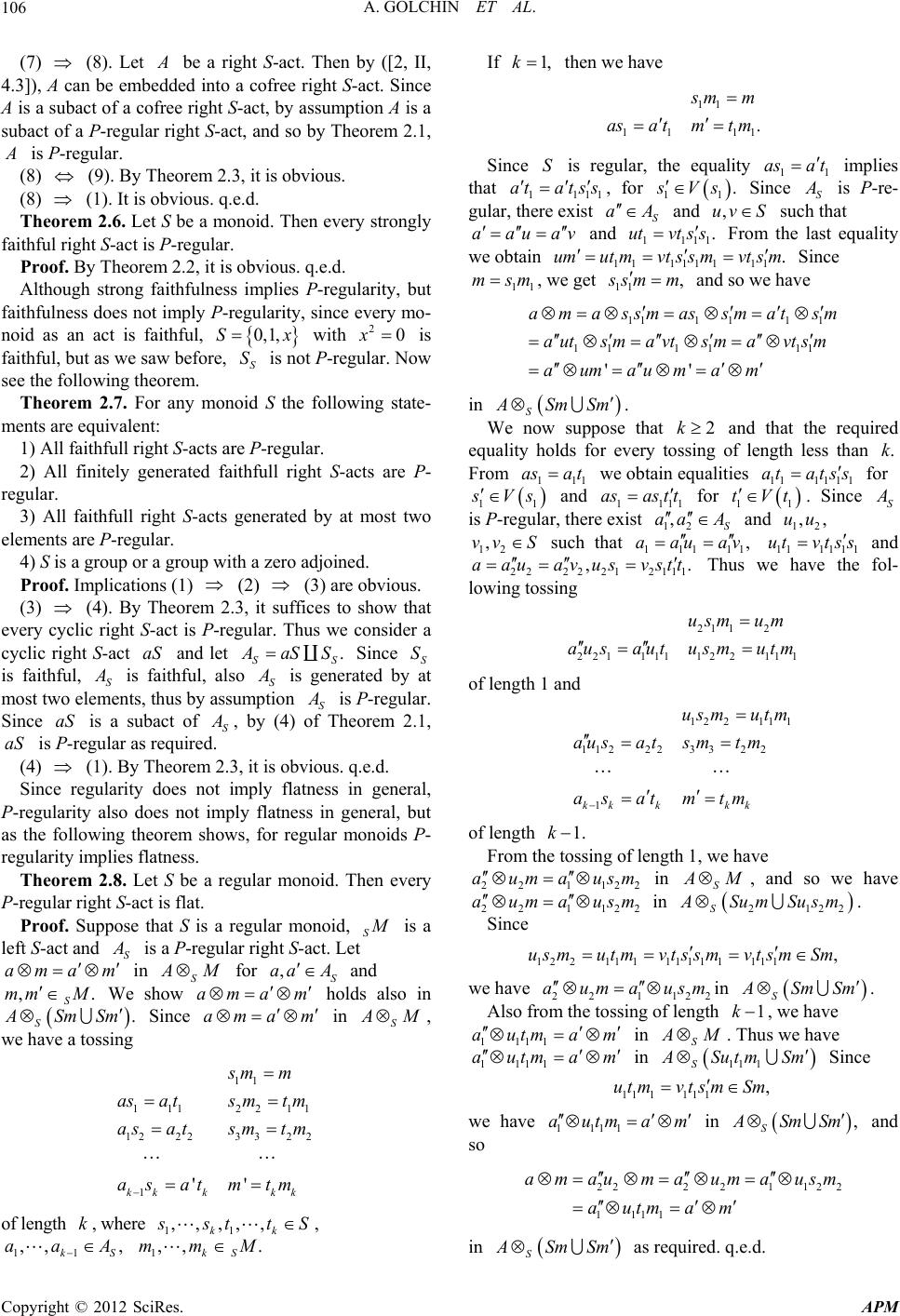 A. GOLCHIN ET AL. 106 (7) (8). Let be a right S-act. Then by ([2, II, 4.3]), A can be embedded into a cofree right S-act. Since A is a subact of a cofree right S-act, by assumption A is a subact of a P-regular right S-act, and so by Theorem 2.1, is P-regular. (8) (9). By Theorem 2.3, it is obvious. x20x (8) (1). It is obvious. q .e.d. Theorem 2.6. Let S be a monoid. Then every strongly faithful right S-act is P-regular. Proof. By Theorem 2.2, it is obvious. q.e.d. Although strong faithfulness implies P-regularity, but faithfulness does not imply P-regularity, since every mo- noid as an act is faithful, with 0, 1,S is faithful, but as we saw before, is not P-regular. Now see the following theorem. S S . Theorem 2.7. For any monoid S the following state- ments are equivalent: 1) All faithfull right S-acts are P-regular. 2) All finitely generated faithfull right S-acts are P- regular. 3) All faithfull right S-acts generated by at most two elements are P-regular. 4) S is a group or a group with a zero adjoined. Proof. Implications (1) (2) (3) are obvious. (3) (4). By Theorem 2.3, it suffices to show that every cyclic right S-act is P-regular. Thus we consider a cyclic right S-act and let SS aS aSSS Since S is faithful, S is faithful, also S is generated by at most two elements, thus by assumption S is P-regular. Since is a subact of aS S , by (4) of Theorem 2.1, is P-regular as required. aS (4) (1). By Theorem 2.3, it is obvious. q.e.d. S Since regularity does not imply flatness in general, P-regularity also does not imply flatness in general, but as the following theorem shows, for regular monoids P- regularity implies flatness. Theorem 2.8. Let S be a regular monoid. Then every P-regular right S-act is flat. Proof. Suppose that S is a regular monoid, is a left S-act and S is a P-regular right S-act. Let in S am a m Mam for S and We show holds also in S ,aa a A m , SM . . mm Sm Sm Since in ama m S M , we have a tossing 11 2211 3 32 2 '' kk sm m smt m sm tm m tm 11 ,,, kk 11 1 12 22 1 kk k as a t as at as at of length , where k,, stt S . kS M 1,k , 1 1 ,, , kS aaA 1,,mm If then we have 11 11 11 . mm asa tmt m S1 asa t Since is regular, the equality 1 at atss implies that 1 111 , for 1 1 .Vs Since S is P-re- gular, there exist S aA and uv such that ,S aa uav 1111 .vt s s and ut From the last equality we obtain 1 1111 111.umutm vtssm vtsm 11 msm Since , we get 11 , smm and so we have 111 11 1 11 1111 '' amassmassmat sm autsm avtsm avtsm aumaumam Sm Sm in S 2k.k 1 asa t . We now suppose that and that the required equality holds for every tossing of length less than From 11 we obtain equalities 11 1111 at atss for 11 Vs 111 asas tt and 1 for 1. Since 1 tVt S is P-regular, there exist 12 ,S aaA 12 ,, 12 ,vv S and uu such that 11111 ,aauav ut vtss 111111 2 12 111 ,.aauavus vstt and 222 2 21 12 22111112211 1 usmum ausaut usmutm 122111 112223 32 2 1 kk kkk usm utm ausat sm tm asatm tm 1.k Thus we have the fol- lowing tossing of length 1 and of length From the tossing of length 1, we have 22 1122 aumausm S in M 1122 aumausm , and so we have 22 2122S in SumSusm 122111 11111 111,usmutm vtssmvtsmSm . Since 22 1122 aumausm we have S in Sm Sm 1k 1111 autmam . Also from the tossing of length , we have S in M . Thus we have 1111 autmam in 11 1SSut mSm 11111 1,utmvtsm Sm Since 1111 autmam we have , S in Sm Sm 2222112 2 1111 amaumauma usm autmam and so S Sm Sm in as required. q.e.d. Copyright © 2012 SciRes. APM 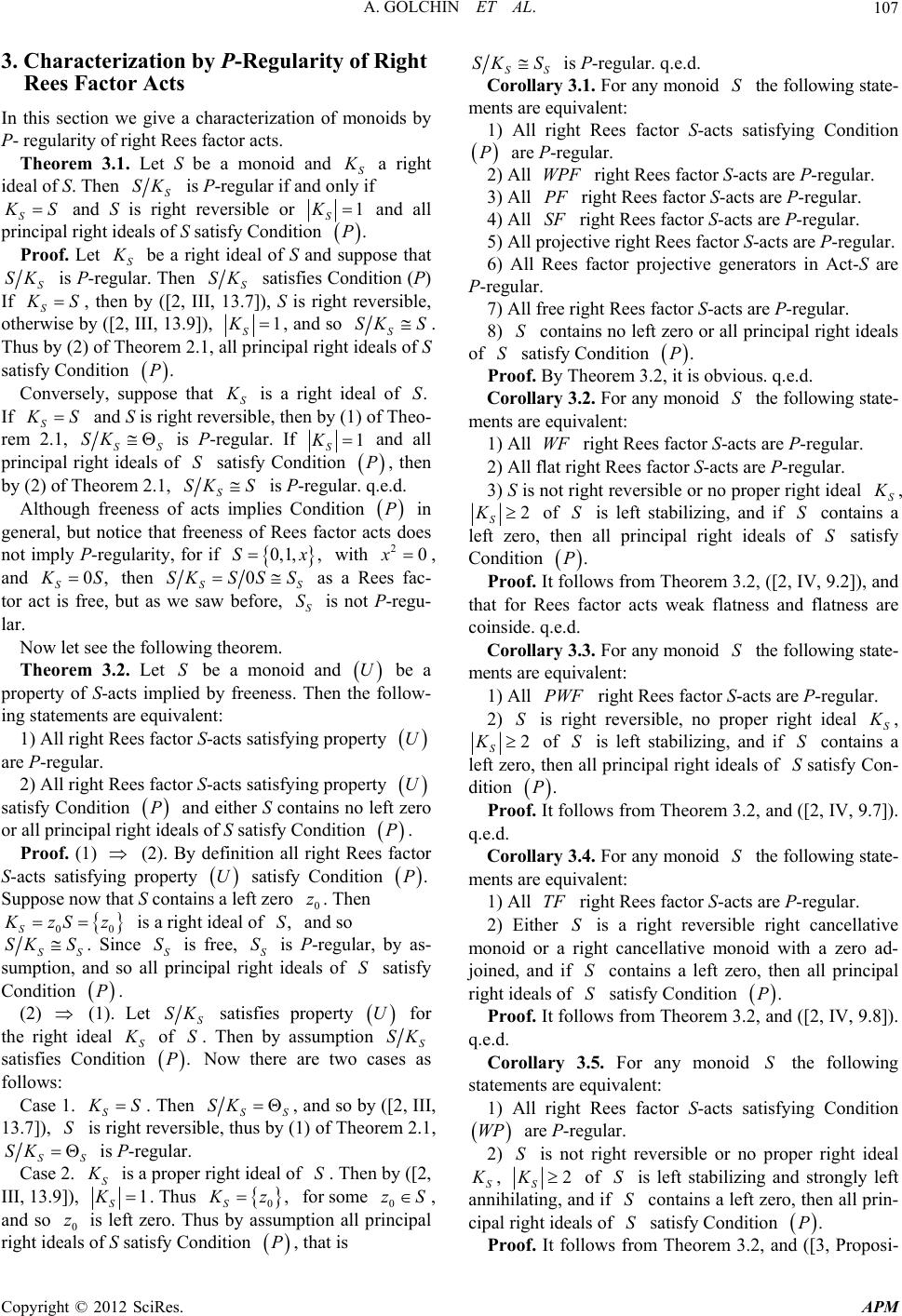 A. GOLCHIN ET AL. 107 3. Characterization by P-Regularity of Right Rees Factor Acts In this section we give a characterization of monoids by P- regularity of right Rees factor acts. Theorem 3.1. Let S be a monoid and S a right ideal of S. Then S is P-regular if and only if S SK S and S is right reversible or 1K S and all principal right ideals of S satisfy Condition .P Proof. Let S be a right ideal of S and suppose that S SK is P-regular. Then S satisfies Condition (P) If S SK S, then by ([2, III, 13.7]), S is right reversible, otherwise by ([2, III, 13.9]), 1K S, and so S SK S . Thus by (2) of Theorem 2.1, all principal right ideals of S satisfy Condition .P Conversely, suppose that S is a right ideal of If S .S S and S is right reversible, then by (1) of Theo- rem 2.1, SS is P-regular. If SK 1 S K and all principal right ideals of satisfy Condition S P, then by (2) of Theorem 2.1, S SK S is P-regular. q.e.d. Although freeness of acts implies Condition P ,x20x in general, but notice that freeness of Rees factor acts does not imply P-regularity, for if with 0, 1,S , and S0, S then 0S SK S S S as a Rees fac- tor act is free, but as we saw before, is not P-regu- lar. S S SS Now let see the following theorem. Theorem 3.2. Let be a monoid and U be a property of S-acts implied by freeness. Then the follow- ing statements are equivalent: 1) All right Rees factor S-acts satisfying property U -regular. are P 2) All right Rees factor S-acts satisfying property U fy Condition P anither S contains no left zero or all principal right ideals of S satisfy Condition satis d e P. Proof. -acts satisfyin (1) (2). By definiti Rees factor gon all right S property U satisfy Condition .P Suppose now that S containseft zero 0 z. Then 00S a l zS z is a right ideal of ,S and so SS S. by as- p SK Since ). S S is free, S S P-regular, and so alrincipal right ideals of S satisfy Condition P. (2) (1Let is sumtion,l p S SK erty satisfies prop U for the rigideal S ht o Then by assumptionf S.S K satisfies Conditi PNow there are two cas follows: Case 1 S on . es as . S S. Then SS SK so by ([2, III, le, thus by , and 13.7]), S reversib(1) of Theorem 2.1, is right SS SK is P-regular. S Case 2. is a proper right ideal of S. Then by ([2, III, 13.9]), 1 S. Thus 0, S K z fo some 0 zSr , and so 0 z ption all prl right ides of S satisfy Condition P, that is is left zero. Thus by assuincipa al m SS SK S is P-regula r . q.e. d. y 3.1. For any monoiCorollar d S the following state- mfactor S-acts satisfying Condition ents are equivalent: 1) All right Rees are P-regular. ) All WPF righ P 2t Rees factor S-acts are P-regular. PF SF roj lar. P-e right Rees factor S-acts are P-regular. deals of s 3) All right Rees factor S-acts are P-regular. 4) All right Rees factor S-acts are P-regular. 5) All pective right Rees factor S-acts are P-regu 6) All Rees factor projective generators in Act-S are regular. 7) All fre 8) S contains no left zero or all principal right i Satisfy Condition .P P oof. By Theorem 3.2s obr, it ivious. q.e.d. ing state- mees factor S-acts are P-regular. lat rl S Corollary 3.2. For any monoid S the follow ents are equivalent: 1) All WF right R 2) All fight Rees factor S-acts are P-regular. 3) S is not right reversible or no proper right idea , 2 S of S is left stabilizing, and if S contain , the all principal right ideals f S satisfy Condition Ks a left zerono .P Proof. Itw follos from Theorem 3.2, ([2, IV, 9.2]), and th . For any monoid S the following state- mRees factor S-acts are P-regular. is righ at for Rees factor acts weak flatness and flatness are coinside. q.e.d. Corollary 3.3 ents are equivalent: 1) All PWF right 2) S t reversible, no proper right ideal S , 2Ks left zero a S of S is left stabilizing, and if S containa , thenll princip al right ideals of Ssatisfy Con- dition .P Proo fof. It llows from Theorem 3.2, and ([2, IV, 9.7]). q. llary 3.4. For any monoid S the following state- mes factor S-acts are P-regular. er tive mri S e.d. Coro ents are equivalent: 1) All TF right Re 2) EithS is a right reversible right cancella onoid or a ght cancellative monoid with a zero ad- joined, and if S contains a left zero, then all principal right ideals of satisfy Condition .P Proof. It folls from Theorem 3.2, ad own([2, IV, 9.8]). q. ollary 3.5. For any monoid S the following st r S-acts satisfying Condition e.d. Cor atements are equivalent: 1) All right Rees facto P are P-regular. S is not right r W 2) eversible or no proper right ideal S , 2 S of S is left stabilizing and strongly left ihnd if S contains a left zero, then all prin- cipal right ideals of satisfy Condition K ann ilating, aS .P Proof. It follows m Theorem 3.2, and fro([3, Proposi- Copyright © 2012 SciRes. APM 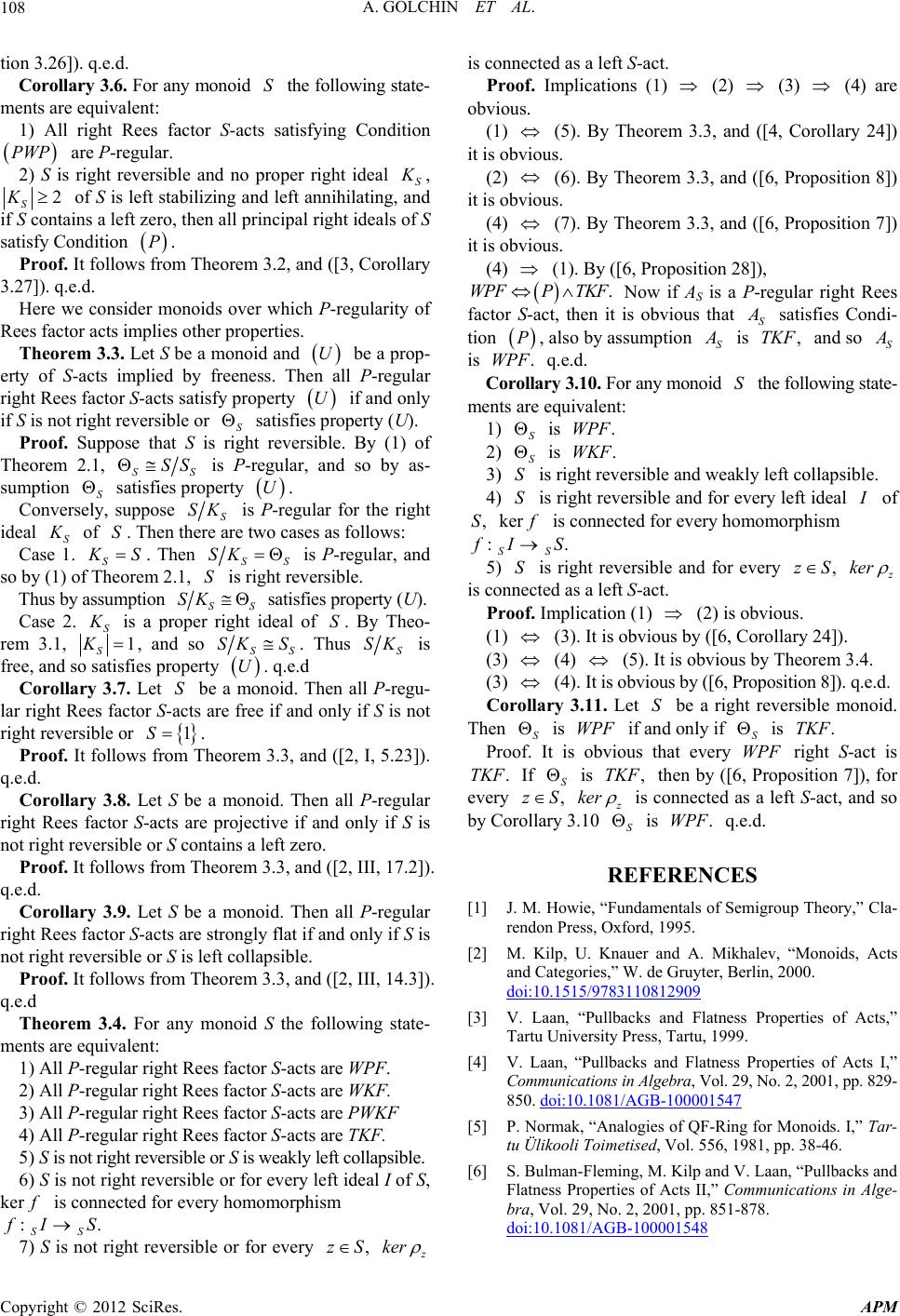 A. GOLCHIN ET AL. Copyright © SciR APM 108 tio o monoid S the following state- mfactor S-acts satisfying Condition P 2) S ie and no propeght ideal S 2012 es. n 3.26]). q.e.d. Corollary 3.6. Fis (2) (3) (4) are ob connected as a left S-act. Proof. Implications (1) r any ents are equivalent: 1) All right Rees vious. (1) (5). By Theorem 3.3, and ([4, Corollary 24]) it vio WP are P-regular. s right reversiblis obus. (2) (6). B r ri, 2 S of S is left stabilizing and left ann ihilating,d ains a left zero, then all principal right ideals of S satisfy Condition P. Proof. It follow y Theorem 3.3, and ([6, Proposition 8]) it vio K an if S cont s from Theorem 3.2 ([3, Corollary 3. nsider monoids over which P-regularity of R U be a prop- er n a , and is obus. (4) (7). By Theorem 3.3, and ([6, Proposition 7]) it vio. By ([6, Proposition 28]), is obus. (4) (1) 27]). q.e.d. Here we co .PFPTKF Now if AS is a P-regu t is obvious that S Wlar right Rees factor S-act, then i satisfies Condi- tion P, also by assumption S is,KF and so S ees factor acts implies other properties. Theorem 3.3. Let S be a monoid and T is W q.e.d. Corollary 3.10. .PF For any monoid S the following state- m ty of S-acts implied by freeness. Thell P-regular right Rees factor S-acts satisfy property U if and only if S is not right reversible or S satisfies operty (U). Proof. Suppose that S is ht reversible. By (1) of ents are equivalent: 1) S is .WPF pr rig Theorem 2.1, SS SS atisfies pr is P-regular, and so by as- sumption S soperty U. Conversel, suppose yS SK is egP-rular for the right ideal S of S. Then thre two cases as follows: Cas. S ere a e 1 S. Then SS SK is P-regular, and S is right rso by (1) ofm 2.1, eversible. Thus by assumption Theore SS SK satisfies property (U). Case 2. S is a prideal of S. By Theo-oper t righ rem 3.1, 1K, and so SSS SK S. Ths uS SK is free, and so satisfies property . q.e. on U men all P-regu- la ac from Teorem 3.3, and ([2, I, 5.23]). q. ollary 3.8. Let S be a monoid. Then all P-regular rig 2, III, 17.2 ]). q. ollary 3.9. Let S be a monoid. Then all P-regular rig ([2, III, 14 q. orem 3.4. For any monoid S the following state- mt Rees factor S-acts are WPF. ke S 7) S is not right reveev,zS ker d Corollary 3.7. Let S be aoid. Th r right Rees factor S-ts are free if and only if S is not right reversible or 1S. Proof. It followsh e.d. Cor ht Rees factor S-acts are projective if and only if S is not right reversible or S contains a left zero. Proof. It follows from Theorem 3. 3, and ([ e.d. Cor ht Rees factor S-acts are strongly flat if and only if S is not right reversible or S is left collapsible. Proof. It follows from Theorem 3. 3, and.3]). e.d The ents are equivalent: 1) All P-regular righ 2) All P-regular right Rees factor S-acts are WKF. 3) All P-regular right Rees factor S-acts are PWKF 4) All P-regular right Rees factor S-acts are TKF. 5) S is not right reversible or S is weakly left collapsible. 6) S is not right reversible or for every left ideal I of S, rf is connected for every homomorphism :. S fI S rsible or for ery 2) S is .WK F S ht revble and weakly left collapsible. S 3) is rigersi 4) is right reversible and for every left ideal of Sr fI 5) S is rit reversible and for every ,zS ker , kef is connected for every homomorphism :. SS S gh is ne (2) is obvious. concted as a left S-act. Proof. Implication (1) (1) (3). It is obvioby ([6, Corollary us 24]). (3) (4) (5). It is obvious by Theorem 3.4. (3) (4). I o bvious by ([6, Proposition 8]). q.e.dt is. lla ThCorory 3.11. Let S be a right reversible monoid. en S is WPF if ad only if S is .TKF ProoIt is ious that every PF rS n f. obvWight -act is T.KF If S is ,TKF then by ([6osition 7]), for zS , Prop every , ker is lary connected as a left S-act, and so by Corol 3.10 S is .WPF q.e.d. REFERENCES [1] J. M. Howie, “roup Theory,” Cla- Mikhalev, “Monoids, Acts Fundamentals of Semig rendon Press, Oxford, 1995. [2] M. Kilp, U. Knauer and A. and Categories,” W. de Gruyter, Berlin, 2000. doi:10.1515/9783110812909 [3] V. Laan, “Pullbacks and Flatness Properties of Acts,” perties of Acts I,” Tartu University Press, Tartu, 1999. [4] V. Laan, “Pullbacks and Flatness Pro Communications in Algebra, Vol. 29, No. 2, 2001, pp. 829- 850. doi:10.1081/AGB-100001547 [5] P. Normak, “Analogies of QF-Ring for Monoids. I,” Tar- ks and tu Ülikooli Toimetised, Vol. 556, 1981, pp. 38-46. [6] S. Bulman-Fleming, M. Kilp and V. Laan, “Pullbac Flatness Properties of Acts II,” Communications in Alge- bra, Vol. 29, No. 2, 2001, pp. 851-878. doi:10.1081/AGB-100001548
|